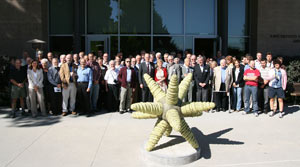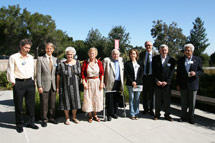
Handy Links
SLAC News Center
SLAC Today
- Subscribe
- Archives: Feb 2006-May 20, 2011
- Archives: May 23, 2011 and later
- Submit Feedback or Story Ideas
- About SLAC Today
SLAC News
Lab News
- Interactions
- Lightsources.org
- ILC NewsLine
- Int'l Science Grid This Week
- Fermilab Today
- Berkeley Lab News
- @brookhaven TODAY
- DOE Pulse
- CERN Courier
- DESY inForm
- US / LHC
SLAC Links
- Emergency
- Safety
- Policy Repository
- Site Entry Form

- Site Maps
- M & O Review
- Computing Status & Calendar
- SLAC Colloquium
- SLACspeak
- SLACspace
- SLAC Logo
- Café Menu
- Flea Market
- Web E-mail
- Marguerite Shuttle
- Discount Commuter Passes
-
Award Reporting Form
- SPIRES
- SciDoc
- Activity Groups
- Library
Stanford
Around the Bay
Symposium Honors Vera Lüth
(Photo by Kelen Tuttle.)
Last Friday more than 100 colleagues and supporters gathered in Kavli Auditorium to celebrate the career and the accomplishments of SLAC Professor Emeritus Vera Lüth.
"Vera has had a spectacular career in particle physics," said SLAC theoretical physicist JoAnne Hewett, who organized the event with SLAC's Marty Breidenbach and Jonathan Dorfan. "Right from the beginning, Vera showed that every experiment she contributed to was the definitive experiment at the time."
Lüth's career began at CERN in Geneva, where she worked with physicist Jack Steinberger and others on an experiment that measured charge-parity violation—an imbalance between matter and antimatter—in the decay of a particle called a neutral kaon.
"It is a particular pleasure for me [to present the highlights of Vera's early career] because I had the chance to work with Vera when we were both a bit younger, some 40 years ago," said Steinberger, who received the Nobel Prize in 1988 for his part in the discovery of the muon neutrino. "I have appreciated her work very much all these years."
After receiving a Ph.D. for her work at CERN, Lüth came to SLAC as a postdoc in 1974. She very quickly proved her worth, said SLAC Director Emeritus Burton Richter, playing an important role at the Stanford Positron Electron Accelerating Ring (SPEAR) during the "November Revolution," which launched a new era of particle physics with the discovery of the charm quark.
In the following years, Lüth was one of the leading physicists on both the magnetic detector built by SLAC and Lawrence Berkeley National Laboratory and the MARK II detector, which recorded data at SPEAR, the Positron Electron Project and the Stanford Linear Collider. Lüth was also the driving force to build the first detector using silicon microstrips at a colliding beam machine.
In 1994, Lüth became the first BaBar technical coordinator, overseeing the design and construction of the BaBar Detector. After its completion, she devoted her effort to measurements on the decay of B mesons and to mentoring to young scientists at SLAC and the BaBar collaboration at large.
In addition, Lüth has been a leader in the physics community for decades. She served the International Union of Pure and Applied Physics, chairing the Committee on Particles and Fields for three of those years. She was a member of numerous advisory committees throughout the U.S. and Europe, including the High Energy Physics Advisory Panel and most recently the Helmholtz Association and the Wissenschaftsrat of Germany. She is also involved in a program supporting the training of young physics teachers in Northern California.
"Everything that Vera worked on was very much a success, and Vera played a driving role on each one," Hewett said. "And all the way, she's done it with style and grace. People have very fond memories of Vera and all that she's done for us. We all wish her the best in her future endeavors."
—Kelen Tuttle
SLAC Today, September 28, 2010

